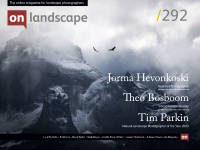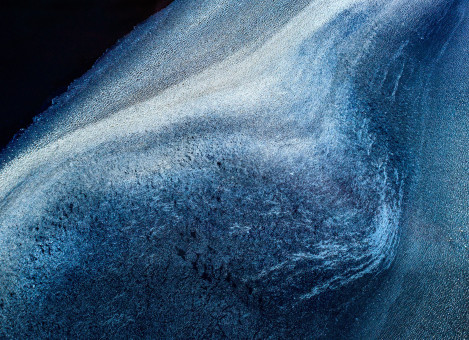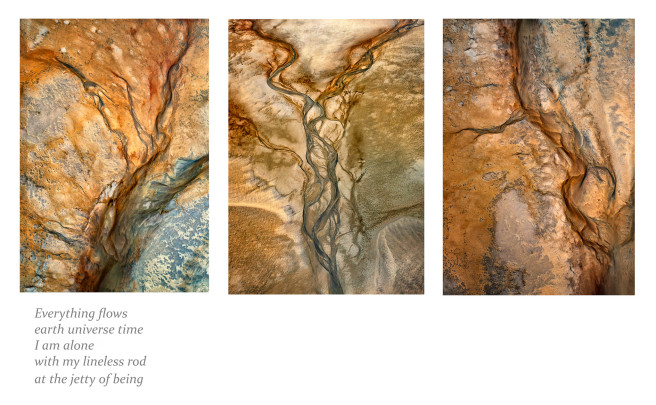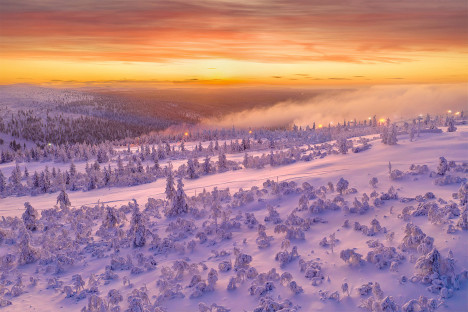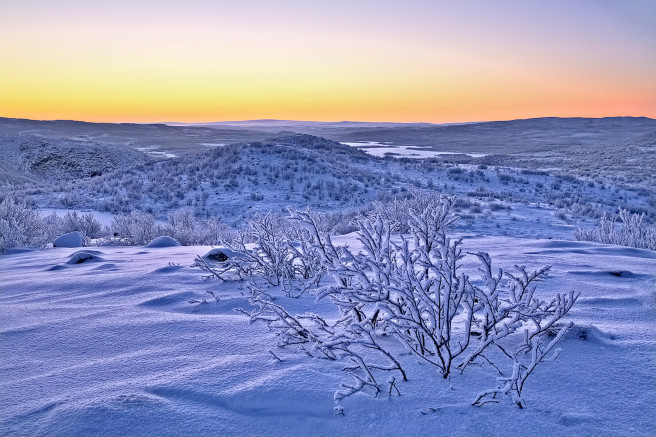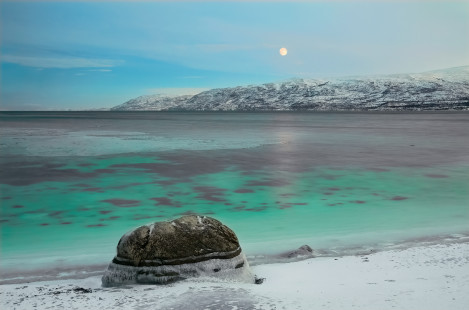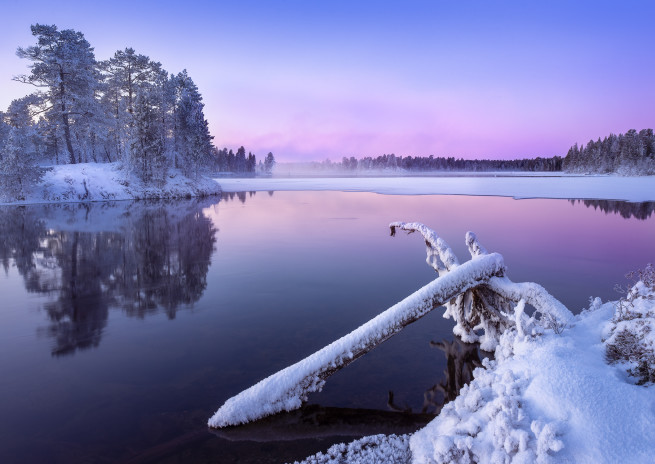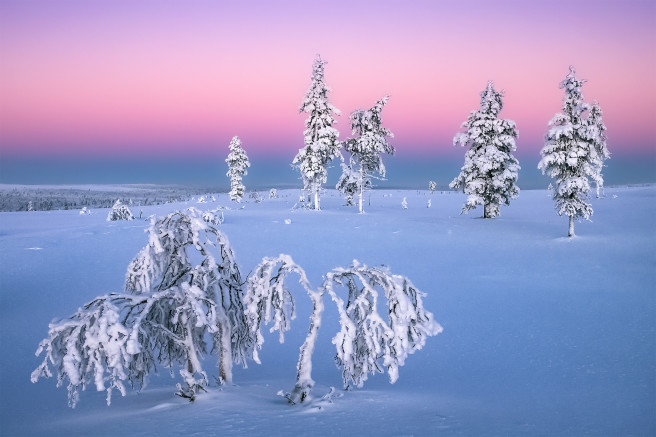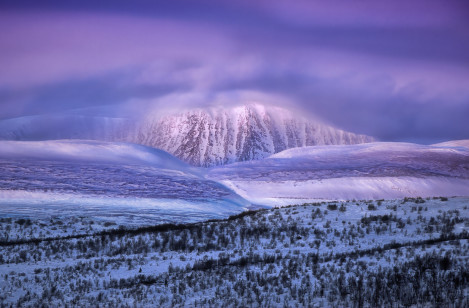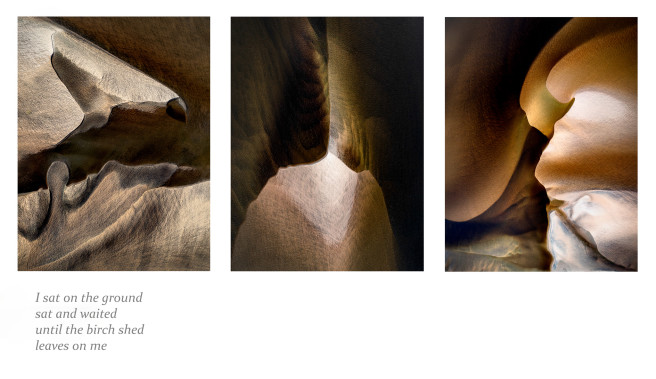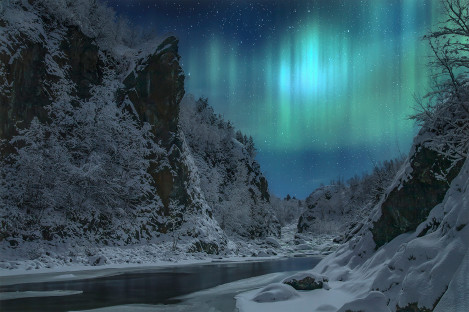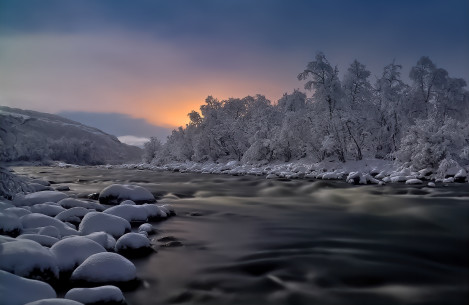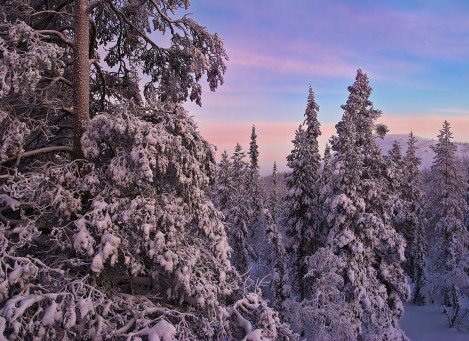Featured Photographer

Jorma Hevonkoski
My name is Jorma Hevonkoski and I live in northern Finland. I moved here 8 years ago when climate change ruined the old comfortable winters in the south. I love photography in winter because of the beautiful light and snow.

Michéla Griffith
In 2012 I paused by my local river and everything changed. I’ve moved away from what many expect photographs to be: my images deconstruct the literal and reimagine the subjective, reflecting the curiosity that water has inspired in my practice. Water has been my conduit: it has sharpened my vision, given me permission to experiment and continues to introduce me to new ways of seeing.
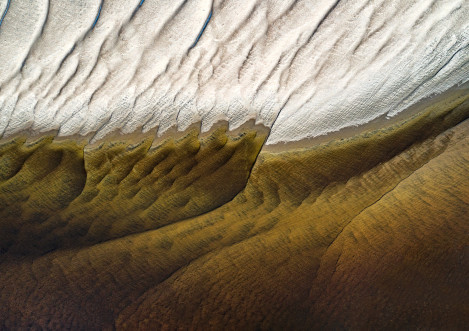
If you have retained your child-like sense of wonder for snow, then it’s likely that you’ll be enthralled by Jorma’s landscapes from the far north of Finland, which are all the more remarkable for the fact that they are taken during the polar night. But before you pack your bags, read on, as it’s certainly not the easiest place to get to and photograph and Jorma, for one, may not be overjoyed if you head there – it’s nothing personal, and I understand the value that he places on both tranquillity and the remaining wild country.
When I first got in touch with Jorma, he was on a fishing trip, and my proposals caused a few surprising ripples. It also gave me an insight into the precious nature of summer that far north, so we’ve waited until October to speak to him, in that period before the long and photogenic winter begins. It would be misleading though, to suggest that our feature is just about those magical landscapes, as the attraction was as much for the abstract images that Jorma makes and the way that he combines these.
Would you like to start by telling readers a little about yourself and your early interests?
I am already over 60 years old and currently live in the very north of Finland, close to the border between Norway and Russia. Since childhood, I have lived in many places around Finland, but the places I love the most are Eastern Finland near Lake Saimaa and Northern Finland. I spent a lot of my childhood in nature, as all children of that time did when nature started right at the doorstep. At that time, nature was still completely untouched; nowadays, this can only be found in the very northern part of the country.
When did you first pick up a camera and what did you photograph at that time? Where did this lead?
When I was young, I wasn't particularly interested in photography, and my family wasn't interested in arts or culture at all. I found photography quite by chance when I wanted photos of car races. I bought a cheap SLR camera, but right away, I noticed that it was rubbish, and I started to buy better equipment. Over the course of a few years, I attended some photography courses taught by really famous domestic and foreign teachers. I mainly did black and white and quite a lot of street and people photography
At the time, I was working on the railways, but after five years as a hobby, I jumped on the train of professional photography and became an assistant in an advertising photography studio.
Along with other photography, I have always been a passionate landscape photographer because, for example, the equipment for bird photography is too expensive and it is nicer to watch animals and their activities than to hunt them. As a young man, it was good to put on a photo exhibition every year, and at that time they were of course black and white because colour photos made from slides were too expensive. We had a good group of friends, and pictures were sometimes put on the walls of bars or in the lobbies of cinemas. A friend and I even made two exhibitions on the wall of the Leningrad Palace of Culture in the Soviet Union. It was nice there, on adventurous photography trips - the longest I spent was five weeks photographing the lives of people in small villages.
During the slide days, I sold quite a lot of pictures for calendars and postcards. More than 35 years ago, you got many times more money for the pictures compared to today's negligible compensations, which seem mostly like contempt for photographers. The same applies to the sale of prints. In the summer, I tried to sell some of my exhibition photos framed under glass at the market here in Lapland. They thought 50 euros for a 50x70cm picture was an outrageous price. The best feedback was when a gentleman told his lady that the frames were good. Trash that picture and replace it with your own pictures. One parliamentarian would have liked to buy a few prints, but nothing has been heard since I said €80 for a 50x70 print. It was probably too cheap a price.
Who (photographers, artists or individuals) or what has most inspired you, or driven you forward in your own development as a photographer?
Although I mainly do colour photography myself, the photographers I greatly appreciate are users of black and white film. The culture of Finnish landscape photography existed perhaps a hundred years ago, and since then, there has not been a generation of photographers who were interested in the subject. That's why only Pentti Sammallahti has been my favourite photographer among the Finns. The world famous Sebastião Salgado is a photographer I really appreciate through his wonderful black and white works—especially his mammoth book "Genesis", which I've been browsing from time to time.
I've also started working on my photos in black and white, but I guess I'm too critical because only a few photos seem to work as I'd like. In Finnish landscape and other nature photography, there seems to be a general perception that nature photography is a piece of cake and that it is possible to make quick profits without hard work.
However, the top is really narrow and, especially in landscape photography, even narrower. There are perhaps a couple of dozen landscape photographers worth considering in Finland, so the appreciation is also minimal. Especially here in the Arctic region, landscape photography requires a lot of work because, many times, it may take three days of hiking or canoeing to get to a good shooting location. I had to stop long hikes after falling ill with rheumatism a few years ago. I had to change my working methods, and moving to the vicinity of roads or boat routes was a must. This was perhaps not a bad thing because this is how I discovered abstract drone landscape photography, and it changed my way of thinking in the right direction. I had been dissatisfied with my shooting style for a long time, which repeated old mannerisms, and the reform was incredibly difficult to do. This has been a difficult change because there has been little or no expert feedback.
It doesn't warm up much, even though there is a lot of praise on social media when you know yourself that something is wrong. The somewhat abstract pictures have received a lukewarm reception, but this work requires a hard head and persistence. The caravan moves, and the dogs bark. You get the best feedback from yourself when you notice that you are constantly developing in the direction that gives you the best satisfaction.
Tell us a little more about where you live and the places that you are repeatedly drawn back to?
I have always enjoyed and almost loved the Arctic region because my mother's family originates - in the 17th century - from Lapland, Norway, from the very small town of Kautokeino. Around Finnish, Swedish and Norwegian Lapland, I have worked in tourism as a group guide, taking tourists fishing in the fishing waters of the fells. Fishing and photography are also mostly my hobbies because you can't make a full-time living here.
On my photography trips, I often travel to northern Norway, which is only a few hours away. Fortunately, there has not yet been an international invasion of photographers to these regions that are dear to me, like, for example, Lofoten, where I will not go even if paid. There, the locals have considered starting to tax photography tourists who block the roads and every parking space. I haven't met another photographer in the northeast for years, and that gives me room to breathe (typical Finnish character). Previously, I couldn't photograph if someone else photographed with me. Nowadays, it doesn't matter. Thank you, ageing.
I began my research by looking through your social media feed to get a sense for the change that takes place over the months. It looks to be a country that is good for the soul; one that fosters a strong connection with nature, land and season. How would you describe the rhythms of life and nature throughout the year? And what are the practicalities?
People in the north say we have eight seasons. Between autumn and winter, there is still early winter, which brings the first snow, and it's freezing even during the day. Before winter, it's time to harvest, which here is either fishing or hunting for winter storage in the freezer. Now, I mainly fish for white fish, which I eat at least once a week. In November, the sun disappears behind the southern horizon, and the polar night begins, lasting a couple of months when the sun is not visible even during the day.
I'm looking forward to the polar night because the ground is covered with snow, and the light is incredibly beautiful - as if the whole bright five hours were painted in golden and pastel colours. During a full moon, it can be so bright that you can read a newspaper. In the upper landscape of Northern Norway, the light is even more wonderful, but it is bright enough only for a couple of hours.
Of course, the winter here is long, and there is usually six months of snow on the ground. You might imagine that winter would be a dark time, but in the north, it is never as dark as in the south because the snow reflects light even in the middle of the night. I have always loved the brightness of winter, and I look forward to winter photography. I have standard filming locations that I go to if the weather is pleasant and particularly cold. The summer lasts for a few months, and then I move around a lot in the large Inarijärvi, which the locals call the Lapland Sea. When the sun doesn't set for a couple of months, sometimes it feels that there is light more than enough.
During the polar night, it can often be really cold, and -30 degrees C is normal. In this weather, you must shoot for less than two hours, and the camera's batteries don't last very long either. I've had -28C when it's very cold to fly a drone, and the device only works really well as long as the batteries are warm. Fingers just get cold easily because the controller has to be handled with open hands sometimes. The worst cold where I have done magazine photography work has been -36C, which was otherwise okay, but the camera's batteries ran out in five minutes, and the lens creaked as if it was about to break. It was funny when the hunter being filmed was hustling with open hands as if he hadn't felt the cold.
Northern Finland is not a famous photography region because we don't have great mountains, lovely waterfalls and rugged coastlines. Here, there is only forest up to the Urals, swamps where you can't see the opposite shore and big lakes where some local wilderness men, who know the conditions well, will drown every year. Tourism is the biggest employer, but the almost industrialised product does not appeal to local people, like the British and Chinese, who come to take pictures of Santa Claus and hurry past quickly when the local reindeer herder is cutting up the reindeer carcass.
Polar nighttime is interesting because it might confuse even a local resident, and the two-month twilight that precedes it evicts those who have moved from the south back to the light pollution of cities in their third year at the latest. This is nicknamed "Arctic hysteria". As a counterweight, the sun doesn't set for two months in the summer, and many suffer from insomnia then. In summer, the only opportunity to take photos is often in the middle of the night, when the light is really beautiful. For tourism, you can easily get to Lapland by flying, as there are several flights a day from Helsinki.
In winter, the situation in Northeastern Norway is even harsher because it is even less populated, and the weather is often hellish. Roads are frequently closed due to the wind, and you can only move according to the schedule behind the plough. Accommodation establishments are closed in winter, and if you can get to one, the price is far from reasonable. On the other hand, if you are used to travelling in Antarctica or Greenland on your photography trips, then the price doesn't matter. OK, but in Norway, you can fly to almost every one of the smallest villages if the weather permits. In summer, Northeast Norway is beautiful and incredibly colourful, with huge flower meadows and rocky small waterfalls. Actually, it is exactly the same landscape as in Scotland.
Would you like to choose 2 or 3 favourite photographs from your own portfolio and tell us a little about why they are special to you, or your experience of making them?
Abstract sand
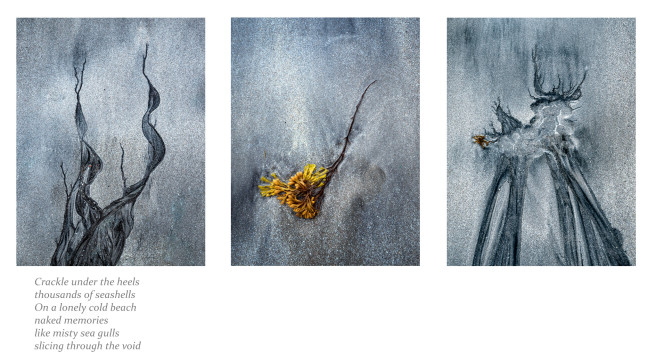
I have several regular photography locations around the north. I've been to a small sandy beach on the Varang fjord in Northern Norway dozens of times and got some nice pictures. The beach is really small and inconspicuous, but the tide can build the best patterns on it for hundreds of kilometres. Or at least what places I know. These triptych pictures were taken 15 years ago, but they have become one of the most beautiful entities when combining pictures. This is also my first triptych and has been an important direction indicator for my later works. What is special about these is that the pictures were taken on the same trip, and the patterns on the beach were absolutely magical then. I have never found exactly the same patterns, even though I try to observe the patterns precisely. Sometimes there have been high waves, and the beach is full of small pieces of seashells, and you can't get anything sensible out of it. In general, I love the very calm sea that caresses the gentle sandy beach, letting the patterns slowly form.
First abstract
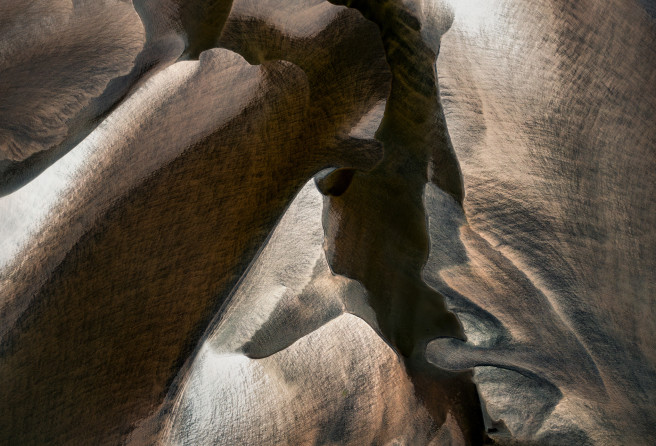
In 2021, I was commissioned to make a video piece about the great Tenojoki in the north. The name of the river in Norwegian is Tanaelva. The river is more than 1km wide in many places and has large sandy areas just above the surface of the river. While flying the drone above the river, my attention was caught by the peculiar shapes drawn on the water-covered sandbanks. The polarising filter clearly revealed what the surface of the water had hidden. This requires completely calm and cloudless weather so that the camera can see below the surface of the water.
This picture is one of the very first abstracts I photographed on the river, and with these pictures, I learned what is required in taming chaos. Very often, when you look at the drone's small monitor, everything looks confused and downright chaotic. The horizontality of the picture also makes it difficult to understand what you see when it would be best to shoot the picture vertically. Today, I've learned to photograph objects vertically, but it required a bit of eye training. I also photograph some objects with several adjacent frames so they cover a large area. With new modern drones, you can also take vertical pictures, but those drones are too expensive to acquire.
This started a photography project that I am still working on now, maybe for several more years. The filming area has expanded from the river Tanaelva to Tanavuono and its huge tidal coast.
The final coast
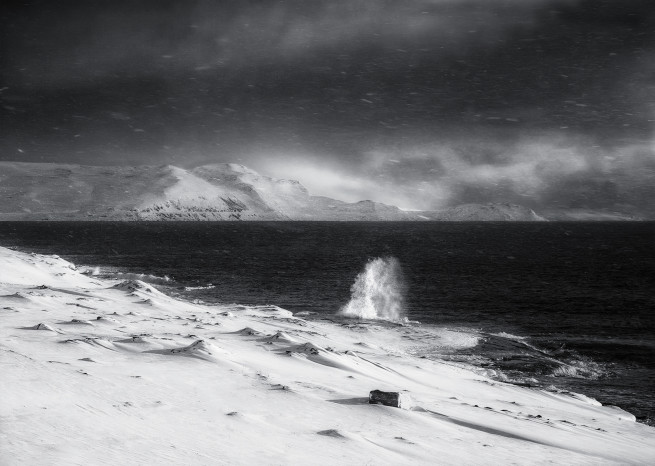
Five years ago, I was working in the wintertime in Northern Norway, and I had just received my first full-frame camera. The previous one was a low resolution small sensor camera, and of course, the difference was really great. When I couldn't afford to buy nice lenses, I had to shoot with cheap Tamron lenses, the brand I still use today.
The winter weather in Finnmark can be really rough, and it's not every day that you feel like going out with your camera. Over 20m/sec wind and bitterly cold will freeze even the roughest, and when the roads may be covered with snowmaking, the journey is not easy. The strongest gusts of wind can knock the car or the photographer off the cliff, and the camera tripod has fallen over many times due to the strong wind, but fortunately, equipment damage has been avoided.
This picture has especially stuck in my mind because of the fierce weather, and it's a great, well-timed shot. There were dozens of photos taken, and everything was right in only one frame.
The light changed in seconds, and you had to wait for just the right splash of water because the height of the waves varied greatly. I was behind the car, taking shelter from the wind so that the picture could be even slightly sharp. The picture has been called "The Final Coast" for a long time because I felt then that this beach in the North Cape is the last one a person can walk on. Next is just the endless sea. The image is noisy and rough, and its colours are only blue, so it fits well in black and white, and its problems are not clearly visible. By some strange thought, I consider this picture to be one of the best I have ever photographed.
You recently exhibited some of your abstracts under the title “Time Passing Through”. You often present them as triptychs. Is this a way of making images that you are increasingly drawn to, and do you have any particular ambitions for the future?
I have never felt that I am very creative or artistic in my own work. However, every now and then, a small spark of artistry has appeared.
I like to tell stories with my pictures, which is why I often group them into groups of three or four pictures that support each other. I have taken them even further in triptych-type ensembles of three very intimate pictures, whose pictures are really close to each other but yet different. Connecting three pictures into a story is quite difficult, and I have a lot of beginnings of two pictures, but the third, perhaps the most important one, is missing. These are also live all the time, and a new picture might be a better option than the original. I think that normal landscape photography will gradually become less popular because it has not recently given me as much satisfaction as slightly more artistic interpretations. I've also started writing poems which would be shown alongside abstract triptychs; maybe in the next exhibition, I'll connect poems with the pictures in some way. Anyway, I'm excited about writing, and I've been saving short story blanks and notes. I have written some magazine articles, but the more creative writing has had less attention.
Can you give readers a brief insight into your set up – from photographic equipment through processing to printing? Which parts of the workflow especially interest you and where do you feel you can make the most difference to the end result?
I work with photography almost every day, either taking pictures or processing or printing some interesting pictures. I had a 15-year break from photography from 1991 when all my equipment was stolen. I started taking photos again 20 years ago when the first reasonably priced SLR camera came on the market. I have copied some exhibition photos from that time and they work perfectly well alongside those taken with modern cameras. They require somewhat more fine-tuning, but today's Photoshop makes it easier than with the early versions. When I got a printer a couple of years ago, it radically changed my image processing. From the prints, I could clearly see what was bad in the processing and what needed to be improved, and I began to fully study image processing.
My filming equipment is quite normal and very affordable. A Nikon D750 camera and lenses made by Tamron and some ancient Nikkors from the 80s. Of these, I use the PC 35/2.8 Nikkor a lot because I often take panoramic photos and this lens is really well suited for that. I have the distance adjustment taped on, and I almost always use f22, which is very sharp and gives a large depth of field. With it, you can shoot really large and incredibly sharp multi-line panoramas or just two-image horizontal panoramas whenever you want.
My drone equipment - a Mavic 2 Pro - is also starting to get old, but when it works and with the current Photoshop, you can get perfectly decent 60x90cm prints from even a small-cell image file, so I haven't needed an update. I have developed my shooting and image processing technique as well as it is possible with my skills, and now I am satisfied with it. In particular, the drone requires an effective polarisation filter for these water pictures, without which I might not have found these abstracts. Now, the Nisi landscape filter is always attached to the camera, and I almost never even take it off. I have sometimes used graduated filters, but by bracketing the images and post-processing you get a better result.
We all start off thinking that our photography is about place, subject, season… only at some point to realise that we are intrinsically part of it in what we respond to, and what we choose to show. What have you discovered through photography?
I think I have learned to understand and appreciate other forms of art. Even modern art is, to some extent, okay. This also leads to the fact that I have worked with several artists to photograph their work, and I also photographed for a book about the art collections of Kouvola city.
If you had to take a break from all things photographic for a week, what would you end up doing? What other hobbies or interests do you have? I’ve a feeling that fishing may get a mention, as you caught something unexpected on the day that my first email reached you!
Besides photography, I don't really have any other hobbies other than wilderness life. I also travel to other Nordic countries, usually for fishing and taking photos. I wish that writing would become even more important, but I can't promise that.
I also enjoy cooking and baking from time to time. This week, I have been baking almost every day when the weather has been bad for photography.
Is there a landscape photography ‘scene’ or community in Finland? What subjects and styles are popular, and have there been any noticeable shifts in the time that you’ve been making images?
There are thousands of nature photography enthusiasts in Finland, and up to 25,000 photos are entered into the annual nature photography competition. There are about 2,500 landscape pictures, but the quality of the pictures is not very convincing. I have participated a few times and always placed in the top ten. However, I'm not that interested in the competition because the judging of the pictures seems to be random between different years. To some extent, I have participated in international competitions and had some success, especially a few gold medals and other top places in the Nordic Society of Photography competitions. These are interesting because the pictures are not sorted into different categories, but portraits, art pictures and landscape pictures compete in the same series. I have often been the only awarded landscape photographer.
And finally, is there someone whose photography you enjoy - perhaps someone that we may not have come across - and whose work you think we should feature in a future issue? They can be amateur or professional.
I could suggest a Finn who is more of an art landscape photographer than me: Kirsi Mackenzie.
Thanks very much, Jorma. You’ve given us a fascinating insight into your life. I’m sure readers will appreciate your photography and the direction that you are taking and want to wish you well with your exhibition plans and writing.
You’ll find Jorma’s website at www.wildlight.fi, and you can also connect with him on Instagram.

